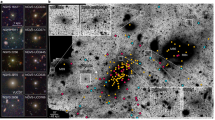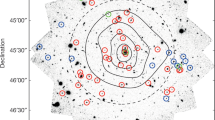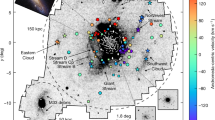Abstract
Most massive galaxies are thought to have formed their dense stellar cores in early cosmic epochs1,2,3. Previous studies have found galaxies with high gas velocity dispersions4 or small apparent sizes5,6,7, but so far no objects have been identified with both the stellar structure and the gas dynamics of a forming core. Here we report a candidate core in the process of formation 11 billion years ago, at redshift z = 2.3. This galaxy, GOODS-N-774, has a stellar mass of 100 billion solar masses, a half-light radius of 1.0 kiloparsecs and a star formation rate of  solar masses per year. The star-forming gas has a velocity dispersion of 317 ± 30 kilometres per second. This is similar to the stellar velocity dispersions of the putative descendants of GOODS-N-774, which are compact quiescent galaxies at z ≈ 2 (refs 8, 9, 10, 11) and giant elliptical galaxies in the nearby Universe. Galaxies such as GOODS-N-774 seem to be rare; however, from the star formation rate and size of this galaxy we infer that many star-forming cores may be heavily obscured, and could be missed in optical and near-infrared surveys.
solar masses per year. The star-forming gas has a velocity dispersion of 317 ± 30 kilometres per second. This is similar to the stellar velocity dispersions of the putative descendants of GOODS-N-774, which are compact quiescent galaxies at z ≈ 2 (refs 8, 9, 10, 11) and giant elliptical galaxies in the nearby Universe. Galaxies such as GOODS-N-774 seem to be rare; however, from the star formation rate and size of this galaxy we infer that many star-forming cores may be heavily obscured, and could be missed in optical and near-infrared surveys.
This is a preview of subscription content, access via your institution
Access options
Subscribe to this journal
Receive 51 print issues and online access
$199.00 per year
only $3.90 per issue
Buy this article
- Purchase on Springer Link
- Instant access to full article PDF
Prices may be subject to local taxes which are calculated during checkout




Similar content being viewed by others
References
Daddi, E. et al. Passively evolving early-type galaxies at 1.4≲z≲2.5 in the Hubble Ultra Deep Field. Astrophys. J. 626, 680–697 (2005)
Oser, L., Ostriker, J. P., Naab, T., Johansson, P. H. & Burkert, A. The two phases of galaxy formation. Astrophys. J. 725, 2312–2323 (2010)
van Dokkum, P. et al. Dense cores in galaxies out to z = 2.5 in SDSS, UltraVISTA, and the five 3D-HST/CANDELS fields: number density, evolution, and the apparent need for efficient cooling at high redshift. Astrophys. J. (submitted); preprint at http://arxiv.org/abs/1404.4874 (2014)
Tacconi, L. et al. Submillimeter galaxies at z ∼ 2: evidence for major mergers and constraints on lifetimes, IMF, and CO-H2 conversion factor. Astrophys. J. 680, 246–262 (2008)
Toft, S. et al. Submillimeter galaxies as progenitors of compact quiescent galaxies. Astrophys. J. 782, 68 (2014)
Barro, G. et al. CANDELS+3D-HST: compact SFGs at z ∼ 2 – 3, the progenitors of the first quiescent galaxies. Preprint at http://arxiv.org/abs/1311.5559 (2013)
Williams, C. C. et al. The progenitors of the compact early-type galaxies at high redshift. Astrophys. J. 780, 1 (2014)
Bezanson, R., van Dokkum, P., van de Sande, J., Franx, M. & Kriek, M. Massive and newly dead: discovery of a significant population of galaxies with high-velocity dispersions and strong Balmer lines at z ∼ 1.5 from deep Keck spectra and HST/WFC3 imaging. Astrophys. J. 764, L8 (2013)
van Dokkum, P. G., Kriek, M. & Franx, M. A high stellar velocity dispersion for a compact massive galaxy at redshift z = 2.186. Nature 460, 717–719 (2009)
van de Sande, J. et al. Stellar kinematics of z ∼ 2 galaxies and the inside-out growth of quiescent galaxies. Astrophys. J. 771, 85 (2013)
Belli, S., Newman, A. B. & Ellis, R. S. Velocity dispersions and dynamical masses for a large sample of quiescent galaxies at z > 1: improved measures of the growth in mass and size. Astrophys. J. 783, 117 (2014)
Skelton, R. E. et al. 3D-HST WFC3-selected photometric catalogs in the five CANDELS/3D-HST fields: photometry, photometric redshifts and stellar masses. Preprint at http://arxiv.org/abs/1403.3689 (2014)
van der Wel, A. et al. 3D-HST+CANDELS: the evolution of the galaxy size-mass distribution since z = 3. Astrophys. J. 788, 28 (2014)
Kriek, M. et al. An ultra-deep near-infrared spectrum of a compact quiescent galaxy at z = 2.2. Astrophys. J. 700, 221–231 (2009)
Szomoru, D. et al. Confirmation of the compactness of a z = 1.91 quiescent galaxy with Hubble Space Telescope’s Wide Field Camera 3. Astrophys. J. 714, L244–L248 (2010)
Kirkpatrick, A. et al. GOODS-Herschel: impact of active galactic nuclei and star formation activity on infrared spectral energy distributions at high redshift. Astrophys. J. 759, 139 (2012)
Kennicutt, R. C., Jr Star formation in galaxies along the Hubble sequence. Annu. Rev. Astron. Astrophys. 36, 189–232 (1998)
Chabrier, G. Galactic stellar and substellar initial mass function. Publ. Astron. Soc. Pacif. 115, 763–795 (2003)
Wuyts, S. et al. Galaxy structure and mode of star formation in the SFR-mass plane from z ∼ 2.5 to z ∼ 0.1. Astrophys. J. 742, 96 (2011)
da Cunha, E., Charlot, S. & Elbaz, D. A simple model to interpret the ultraviolet, optical and infrared emission from galaxies. Mon. Not. R. Astron. Soc. 388, 1595–1617 (2008)
Kennicutt, R. C., Jr The global Schmidt law in star-forming galaxies. Astrophys. J. 498, 541 (1998)
Dekel, A. et al. Toy models for galaxy formation versus simulations. Mon. Not. R. Astron. Soc. 435, 999–1019 (2013)
Maiolino, R. et al. AMAZE. I. The evolution of the mass-metallicity relation at z > 3. Astron. Astrophys. 488, 463–479 (2008)
Leja, J. et al. Exploring the chemical link between local ellipticals and their high-redshift progenitors. Astrophys. J. 778, L24 (2013)
Dekel, A. & Burkert, A. Wet disk contraction to galactic blue nuggets and quenching to red nuggets. Mon. Not. R. Astron. Soc. 438, 1870 (2014)
Erb, D. K. et al. α observations of a large sample of galaxies at z ∼ 2: implications for star formation in high-redshift galaxies. Astrophys. J. 647, 128–139 (2006)
Gilli, R. et al. ALMA reveals a warm and compact starburst around a heavily obscured supermassive black hole at z = 4.75. Astron. Astrophys. 562, A67 (2014)
Wang, W.-H., Barger, A. J. & Cowie, L. L. A Ks and IRAC selection of high-redshift extremely red objects. Astrophys. J. 744, 155 (2012)
Barro, G. et al. Keck-I MOSFIRE spectroscopy of compact star-forming galaxies at z≳2: high velocity dispersions in progenitors of compact quiescent galaxies. Preprint at http://arxiv.org/abs/1405.7042 (2014)
Grogin, N. et al. CANDELS: the Cosmic Assembly Near-infrared Deep Extragalactic Legacy Survey. Astrophys. J. Suppl. Ser. 197, 35 (2011)
Koekemoer, A. et al. CANDELS: the Cosmic Assembly Near-infrared Deep Extragalactic Legacy Survey — the Hubble Space Telescope observations, imaging data products and mosaics. Astrophys. J. Suppl. Ser. 197, 36 (2011)
Whitaker, K. et al. The NEWFIRM medium-band survey: photometric catalogs, redshifts, and the bimodal color distribution of galaxies out to z ∼ 3. Astrophys. J. 735, 86 (2011)
Lutz, D. et al. PACS Evolutionary Probe (PEP) - a Herschel key program. Astron. Astrophys. 532, A90 (2011)
Elbaz, D. et al. GOODS-Herschel: an infrared main sequence for star-forming galaxies. Astron. Astrophys. 533, A119 (2011)
Brammer, G. B. et al. 3D-HST: a wide-field grism spectroscopic survey with the Hubble Space Telescope. Astrophys. J. 200, 13 (2012)
Tremonti, C. et al. The origin of the mass-metallicity relation: insights from 53,000 star-forming galaxies in the Sloan Digital Sky Survey. Astrophys. J. 613, 898 (2004)
Steidel, C. et al. Strong nebular line ratios in the spectra of z ∼ 2–3 star-forming galaxies: first results from KBSS-MOSFIRE. Astrophys. J. (submitted); preprint at http://arxiv.org/abs/1405.5473 (2014)
Alexander, D. et al. The Chandra Deep Field North Survey. XIII. 2 Ms point-source catalogs. Astron. J. 126, 539 (2003)
Grimm, H.-J., Gilfanov, M. & Sunyaev, R. High-mass X-ray binaries as a star formation rate indicator in distant galaxies. Mon. Not. R. Astron. Soc. 339, 793 (2003)
Bertin, G., Ciotti, L. & Del Principe, M. Weak homology of elliptical galaxies. Astron. Astrophys. 386, 149–168 (2002)
Trujillo, I. et al. The size evolution of galaxies since z ∼ 3: combining SDSS, GEMS, and FIRES. Astrophys. J. 650, 18–41 (2006)
Toft, S. et al. Hubble Space Telescope and Spitzer imaging of red and blue galaxies at z ∼ 2.5: a correlation between size and star formation activity from compact quiescent galaxies to extended star-forming galaxies. Astrophys. J. 671, 285–302 (2007)
van Dokkum, P. G. et al. Confirmation of the remarkable compactness of massive quiescent galaxies at z ∼ 2.3: early-type galaxies did not form in a simple monolithic collapse. Astrophys. J. 677, L5–L8 (2008)
Cimatti, A. et al. GMASS ultradeep spectroscopy of galaxies at z ∼ 2. II. Superdense passive galaxies: how did they form and evolve? Astron. Astrophys. 482, 21–42 (2008)
Newman, A. B., Ellis, R. S., Treu, T. & Bundy, K. Keck spectroscopy of z > 1 field spheroidals: dynamical constraints on the growth rate of red “nuggets”. Astrophys. J. 717, L103–L107 (2010)
Förster Schreiber, N. M. et al. The SINS survey: SINFONI integral field spectroscopy of z ∼ 2 star-forming galaxies. Astrophys. J. 706, 1364–1428 (2009)
Acknowledgements
Support from STScI grant GO-1277 is acknowledged.
Author information
Authors and Affiliations
Contributions
E.N. obtained the data, led the analysis and the interpretation, and wrote the manuscript. P.v.D. contributed to the analysis and the interpretation. M.F. contributed to the interpretation. I.M. reduced the WFC3 imaging. G.B. and I.M. reduced the grism spectroscopy. K.W. and R.S. led the photometric analysis. All authors commented on the manuscript.
Corresponding author
Ethics declarations
Competing interests
The authors declare no competing financial interests.
Extended data figures and tables
Extended Data Figure 1 Linewidths of z ≈ 2 star-forming and quiescent galaxies.
The linewidth of GOODS-N-774 (open box) is among the highest measured for a normal star-forming galaxy at high redshift in Hα emission26,46 (light blue) or CO emission4 (SMGs; dark blue). The gas velocity dispersion is similar to the median stellar velocity dispersion of 304 km s−1 in a sample of quiescent galaxies at z = 1.5–2.2 with median mass of  (refs 8, 9, 10, 11; red).
(refs 8, 9, 10, 11; red).
Rights and permissions
About this article
Cite this article
Nelson, E., van Dokkum, P., Franx, M. et al. A massive galaxy in its core formation phase three billion years after the Big Bang. Nature 513, 394–397 (2014). https://doi.org/10.1038/nature13616
Received:
Accepted:
Published:
Issue Date:
DOI: https://doi.org/10.1038/nature13616
Comments
By submitting a comment you agree to abide by our Terms and Community Guidelines. If you find something abusive or that does not comply with our terms or guidelines please flag it as inappropriate.



